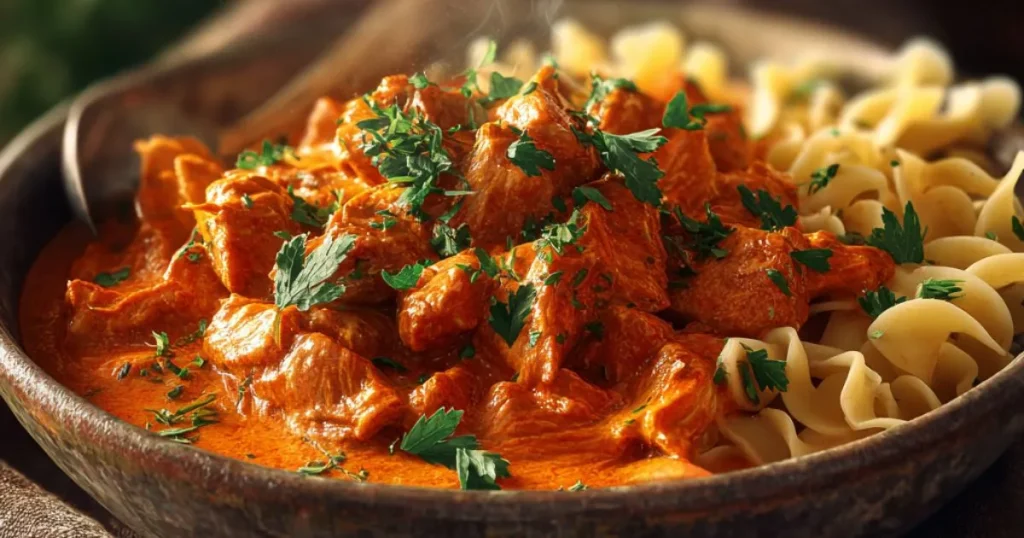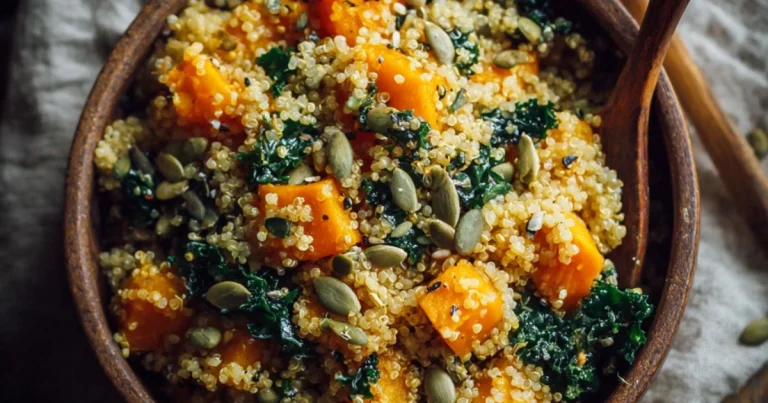Vegan Hungarian “Chicken” Paprikash: The Ultimate Plant-Based Comfort Food
Few dishes evoke comfort, warmth, and deep, smoky flavor quite like Hungarian Paprikash. Traditionally, this iconic stew features tender chicken simmered in a rich paprika-infused sauce. But for plant-based eaters, there’s an equally delicious version — Vegan Hungarian “Chicken” Paprikash. This hearty vegan adaptation delivers all the flavor, texture, and authenticity of the original, but with 100% plant-based ingredients.
Whether you’re new to Hungarian cuisine or a lifelong fan of paprika’s signature aroma, this veganized recipe will win you over with its creamy sauce, tender vegan “chicken,” and rich color. Ready to discover how to make this cozy, flavor-packed meal? Let’s dive into its origins, ingredients, step-by-step preparation, and creative vegan variations.
What Is Vegan Hungarian “Chicken” Paprikash?
Vegan Hungarian “Chicken” Paprikash (or Paprikás Csirke, as it’s known in Hungary) is a traditional dish transformed for the modern vegan kitchen. It replaces animal-based ingredients — like chicken and sour cream — with plant-based alternatives such as soy curls, seitan, or tofu, and creamy cashew or coconut substitutes.
This dish is all about layers of flavor: sweet Hungarian paprika, caramelized onions, garlic, and a velvety tomato-paprika sauce that coats the vegan “chicken.” It’s typically served with nokedli (Hungarian dumplings), egg-free noodles, or rice. The result? Comfort food perfection — smoky, creamy, hearty, and satisfying.
For a classic vegan interpretation of the dish, see this authentic recipe from Monkey & Me Kitchen Adventures.
It captures the heart of traditional Paprikash while keeping everything entirely plant-based.
To understand why this vegan version is so special, it helps to first look at the original Hungarian classic and how it evolved over time. For deeper historical context, check out the overview of Chicken Paprikash on Wikipedia, which outlines its rich culinary roots.
The Origins of Paprikash and Its Vegan Evolution
The traditional Chicken Paprikash (or csirkepaprikás) hails from 19th-century Hungary, where paprika became a defining spice of the national cuisine. Classic versions combine chicken, onions, sour cream, and generous spoonfuls of Hungarian sweet paprika. This fiery-red powder gives the dish its name — “paprikás” literally means “with paprika.”
The vegan evolution preserves everything essential about the dish — warmth, richness, and authenticity — while swapping out the animal ingredients for plant-based alternatives. Vegan cooks have found creative substitutes like soy curls or seitan to mimic the tender chicken texture and cashew cream or coconut milk for the luscious sauce.
If you’d like to explore another great approach, Sarah’s Vegan Kitchen offers a beautiful version that uses plant-based chicken and Hungarian paprika to maintain the flavor depth. You can read her version here: Sarah’s Vegan Chicken Paprikash.
Why Choose Vegan Paprikash?
Going vegan with Paprikash isn’t just about replacing ingredients — it’s about honoring the heart of Hungarian comfort food while embracing a sustainable, compassionate lifestyle. Here are a few benefits of choosing this vegan comfort food:
- Healthier: Lower in saturated fats than traditional meat and cream versions.
- Cruelty-free: No animals harmed, yet still deeply flavorful.
- Environmentally friendly: Uses fewer resources and creates less environmental impact.
- Inclusive: Perfect for mixed-diet households or guests with allergies.
Most importantly, Vegan Hungarian “Chicken” Paprikash tastes indulgent and hearty — proving you don’t need meat or dairy to enjoy authentic Hungarian cuisine.
Key Ingredients for Vegan Hungarian “Chicken” Paprikash
Creating a perfect vegan paprikash relies on high-quality ingredients. Let’s break them down:
1. The “Chicken”
- Soy curls, seitan, or tofu: These absorb flavor beautifully and mimic chicken’s tender bite.
- Chickpeas or oyster mushrooms: Great whole-food alternatives if you prefer less processed ingredients.
2. The Paprika
- Use sweet Hungarian paprika — it’s essential for authentic flavor and vivid color. Avoid generic paprika or smoked versions unless you want a deeper, BBQ-like note.
3. The Sauce Base
- Onions, garlic, and bell peppers sautéed in olive oil or vegan butter.
- Tomato paste or diced tomatoes for richness and body.
- Vegetable broth to simmer the sauce.
4. The Creaminess
- Cashew cream, vegan sour cream, or full-fat coconut milk give that iconic creamy texture.
- Blend soaked cashews with a little lemon juice and broth for a homemade version.
5. Seasonings
- Sweet paprika (main spice)
- A touch of smoked paprika (optional)
- Black pepper, salt, and sometimes marjoram
Step-by-Step Instructions
Follow these easy steps to create your own Vegan Hungarian “Chicken” Paprikash:
- Prepare your vegan “chicken.”
Rehydrate soy curls or slice tofu/seitan. Pat dry and season lightly. - Sauté the aromatics.
In a large skillet, heat olive oil. Add onions and cook until translucent. Stir in garlic and bell peppers. - Add the paprika.
Sprinkle in Hungarian sweet paprika and stir quickly to avoid burning — this is key to unlocking the signature flavor. - Build the sauce.
Add tomato paste and vegetable broth, stirring to combine. Let it simmer until slightly thickened. - Add the “chicken.”
Stir in your vegan protein and coat well with the sauce. Simmer gently for 10–15 minutes. - Finish with creaminess.
Lower heat and stir in cashew cream or vegan sour cream until smooth and velvety. - Serve immediately.
Spoon the stew over noodles, rice, or mashed potatoes. Top with fresh parsley and a dollop of vegan sour cream.

Serving Suggestions and Pairings
Traditionally, Paprikash is served with nokedli (small Hungarian dumplings), but several vegan-friendly sides work just as well:
- Egg-free noodles or spätzle-style dumplings
- Mashed potatoes or rice for a gluten-free option
- Crusty bread to soak up the sauce
- Fresh parsley or dill as garnish
- A dollop of vegan sour cream for extra creaminess
Pair with a glass of crisp white wine or chilled kombucha for balance.
Tips for Perfect Texture and Flavor
To make your Vegan Hungarian “Chicken” Paprikash exceptional, follow these expert tips:
- Use authentic Hungarian paprika for the deepest color and sweetest flavor.
- Never burn the paprika — add it to warm oil and immediately follow with liquid.
- Don’t rush the simmering process; slow cooking enhances the sauce.
- Adjust sauce consistency by adding broth or a cornstarch slurry if needed.
- Store leftovers in the fridge overnight — flavors deepen and improve by the next day.
Creative Variations
One of the best things about Vegan Paprikash is its flexibility. Here are some delicious variations:
- Mushroom Paprikash: Replace vegan chicken with sautéed mushrooms for a rich, earthy version.
- Chickpea Paprikash: Substitute chickpeas for an extra protein boost — see Chickpea Paprikash by Wandering Chickpea for inspiration.
- Gluten-Free Paprikash: Use cornstarch instead of flour, and serve over gluten-free pasta or rice.
- Low-Fat Version: Swap out full-fat coconut milk for light coconut milk or blended silken tofu.
- Spicy Paprikash: Mix in a dash of hot Hungarian paprika or chili flakes for extra heat.
Each variation keeps the soul of the dish intact — smoky paprika, creamy sauce, and cozy, comforting flavor.
Common Mistakes (and How to Avoid Them)
Avoid these pitfalls to keep your vegan paprikash restaurant-quality:
- Burning the paprika: It becomes bitter if fried too long. Add liquid right after seasoning.
- Overcooking vegan chicken: Soy curls or seitan can turn rubbery; simmer gently.
- Sauce too thin or too thick: Balance with broth or cream until silky.
- Too much smoked paprika: It overpowers the sweet Hungarian profile.
- Not enough salt: Remember, paprika-heavy dishes need a touch more seasoning.
Frequently Asked Questions
Q: What can I use instead of vegan “chicken”?
A: Try tofu, tempeh, seitan, or chickpeas — they all absorb sauce well and offer great texture.
Q: Do I need authentic Hungarian paprika?
A: Yes! Sweet Hungarian paprika gives the dish its signature flavor and color. Smoked paprika can be added sparingly for depth.
Q: Can I make this dish gluten-free?
A: Absolutely. Use cornstarch for thickening and gluten-free noodles or rice as the base.
Q: Can I freeze Vegan Paprikash?
A: Yes — store portions in airtight containers and freeze for up to two months. Reheat gently and add broth if needed.
Q: What sides go best with Paprikash?
A: Rice, noodles, or mashed potatoes — anything that soaks up the creamy sauce.
Q: Is it still Hungarian if it’s vegan?
A: Definitely! While it’s adapted, it honors the classic flavors, spices, and slow-cooked richness of traditional Hungarian Paprikash.
Healthier Alternatives and Dietary Modifications
If you’re looking to make a lighter version without sacrificing flavor:
- Reduce oil by sautéing with water or broth.
- Use light coconut milk or blended tofu instead of cashew cream.
- Add more vegetables — mushrooms, zucchini, or spinach can bulk it up.
- Make it high-protein with chickpeas or lentils instead of vegan meat.
- Gluten-free version: Choose gluten-free noodles or rice, and thicken with cornstarch.
These modifications maintain the dish’s richness while tailoring it to different diets.
Why Vegan Hungarian “Chicken” Paprikash Is Perfect for Everyone
This dish hits all the right notes — creamy, cozy, and deeply satisfying. It’s ideal for:
- Family dinners: A comforting meal that pleases everyone.
- Meal prep: Tastes even better reheated the next day.
- Special occasions: Impress guests with a gourmet vegan version of a European classic.
- Beginner cooks: Simple steps, big flavor.
You don’t need to be vegan to love it — it’s pure comfort food in a bowl.
Conclusion
Vegan Hungarian “Chicken” Paprikash proves that comfort food can be compassionate, sustainable, and every bit as delicious as the traditional version. With tender plant-based “chicken,” sweet paprika, and a creamy sauce, it captures the heart of Hungary in a wholesome vegan form.
This dish celebrates the best of both worlds — authentic Hungarian flavor and modern plant-based cooking. Whether you’re







